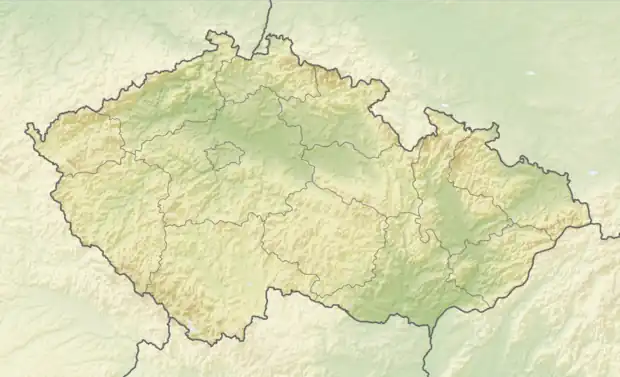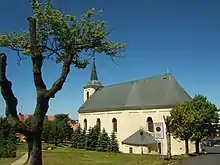Boží Dar | |
|---|---|
 View from the west | |
 Coat of arms | |
 Boží Dar Location in the Czech Republic | |
| Coordinates: 50°24′35″N 12°55′28″E / 50.40972°N 12.92444°E | |
| Country | |
| Region | Karlovy Vary |
| District | Karlovy Vary |
| Founded | 1533 |
| Government | |
| • Mayor | Jan Horník (STAN) |
| Area | |
| • Total | 37.91 km2 (14.64 sq mi) |
| Elevation | 1,028 m (3,373 ft) |
| Population (2023-01-01)[1] | |
| • Total | 350 |
| • Density | 9.2/km2 (24/sq mi) |
| Time zone | UTC+1 (CET) |
| • Summer (DST) | UTC+2 (CEST) |
| Postal code | 362 62 |
| Website | www |
Boží Dar (German: Gottesgab) is a town in Karlovy Vary District in the Karlovy Vary Region of the Czech Republic. It has about 400 inhabitants. Situated in the Ore Mountains at 1,028 m (3,373 ft) above sea level, it is considered the highest town in the Czech Republic. The town is part of the Abertamy – Boží Dar Mining Landscape, which is a UNESCO World Heritage Site as part of Ore Mountain Mining Region.
Administrative parts
Villages of Ryžovna and Zlatý Kopec are administrative parts of Boží Dar.
Etymology
The original German name Gottesgab and the Czech name Boží Dar both literally means 'Gift of God'. The name is said to have come from the statement of the founder of the village, John Frederick I, in which he described the local silver in this way.[2]
Geography


Boží Dar is located about 20 kilometres (12 mi) north of Karlovy Vary, on the border with Germany. It lies in the Ore Mountains. The highest point is the Božídarský Špičák mountain at 1,116 m (3,661 ft) above sea level. The area around Božídarský Špičák with peat bogs is protected as the Božídarské rašeliniště National Nature Reserve.[3]
The Černá creek flows across the municipal territory. The Myslivny Reservoir is supplied by the creek.
History
The remote area in the Saxon Barony of Schwarzenberg was settled after silver and tin mining began about 1517. Boží Dar was founded as a mining town by decree of John Frederick I, Elector of Saxony, who acquired the lordship in 1533. Together with neighbouring Horní Blatná, John Frederick had to cede the town to the Habsburg lands of the Bohemian Crown in 1547 after the Schmalkaldic War and his defeat in the Battle of Mühlberg.[2]
The peak of mining dates back to the 1550s and 1560s, when the town had over 2,000 inhabitants. In 1580, Emperor Rudolf II promoted Boží Dar to the royal mining town. During the Thirty Years' War, the town was looted several times. In 1643, it was plundered by the Swedish army. After the decline of mining in the 17th and 18th centuries, the original important mining town gradually turned into a mountain town, whose inhabitants subsisted on various domestic productions.[2]
After World War I, Boží Dar became part of the First Czechoslovak Republic. It was mainly settled by Sudeten Germans and was one of the municipalities in Sudetenland annexed during the German occupation of Czechoslovakia in 1938. After World War II the German population was expelled.[2] The historic town privileges were lost in the 1950s, but restored in 2006.
Demographics
|
|
| ||||||||||||||||||||||||||||||||||||||||||||||||||||||
| Source: Censuses[4][5] | ||||||||||||||||||||||||||||||||||||||||||||||||||||||||
Transport
Boží Dar is the site of a road border crossing to Oberwiesenthal in Saxony.
Sport
Boží Dar lies in one of the most important winter sport regions in the Czech Republic.The town is known for two ski resorts with several downhill runs and four ski lifts.[6]
Sights
.jpg.webp)
The town belongs to the so-called Abertamy – Boží Dar – Horní Blatná Mining Landscape, which is a UNESCO World Heritage Site as part of Ore Mountain Mining Region.[7] The most valuable remnant of former mining in the area is the Blatenský water ditch. It is a technical monument, protected as a national cultural monument. It was built in 1540–1544 and was used for mining tin ore and for transporting wood. It is 11.6 km (7.2 mi) long and runs across the municipal territory. An educational trail runs along the ditch.[8][9]
The main landmark of the town is the Church of Saint Anne. It was built in the Baroque style in 1771, when it replaced an older Renaissance church.[10]
The late Empire town hall was built in 1844–1845 and together with the church belongs to the landmarks of the town square.[11]
Notable people
- Kaspar Eberhard (1523–1575), Lutheran theologian; local pastor in 1554
- Nikos Kazantzakis (1883–1957), Greek writer; spent several months in Myslivny in 1929–1932
- Lukáš Bauer (born 1977), cross country skier; lives here
References
- ↑ "Population of Municipalities – 1 January 2023". Czech Statistical Office. 2023-05-23.
- 1 2 3 4 "Historie Božího Daru" (in Czech). Město Boží Dar. Retrieved 2023-07-18.
- ↑ "Božídarský Špičák" (in Czech). Město Boží Dar. Retrieved 2022-06-07.
- ↑ "Historický lexikon obcí České republiky 1869–2011 – Okres Karlovy Vary" (in Czech). Czech Statistical Office. 2015-12-21. pp. 3–4.
- ↑ "Population Census 2021: Population by sex". Public Database. Czech Statistical Office. 2021-03-27.
- ↑ "Ski resort". Skiareál Boží Dar. Retrieved 2022-06-07.
- ↑ "Erzgebirge/Krušnohoří Mining Region". UNESCO. Retrieved 2023-07-18.
- ↑ "Blatenský vodní příkop" (in Czech). National Heritage Institute. Retrieved 2023-07-18.
- ↑ "Naučná stezka kolem Blatenského vodního příkopu" (in Czech). CzechTourism. Retrieved 2023-07-18.
- ↑ "Kostel sv. Anny" (in Czech). National Heritage Institute. Retrieved 2023-07-18.
- ↑ "Radnice" (in Czech). National Heritage Institute. Retrieved 2023-07-18.